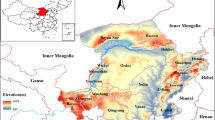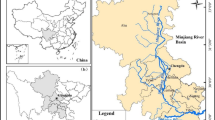Abstract
Yellow River, is designated as “the cradle of Chinese civilization” and played a key role not only in the country’s economic development but also in the historic and cultural identity of the Chinese people. With the rapid economic development and population growth, water demand for industry and households has increased significantly in the Yellow River basin; this has caused an increasing gap between water supply and demand. Competing water demands triggered conflicts between disparate water users on different scales such as the rich and the poor, or between different sectors and regions, such as domestic and agriculture, agriculture and industry, upstream and downstream, rural and urban areas, etc. Ensuring equity in water supply for conflicting water users is one of the major challenges that facing water managers and in particular water management in the Yellow River basin. In this paper, a method has been developed to calculate the Gini coefficient of water use as an indicator to measure the equality in domestic water supply. A dual domestic water use structure model is employed for this purpose. The developed method is subsequently applied to assess the equality in domestic water supply in the Yellow River. Data of population growth, domestic water use and economic development over the time period 1999-2006 are used to calculate the Gini coefficient of water use over the same length of period. The result shows a decreasing trend in Gini coefficient of domestic water use in the Yellow River basin after 2001 which means domestic water use is becoming more and more equitable in the basin. The study justifies that the Gini coefficient of water use can be used and recommended as a useful tool for the water management especially in the context of global change.






Similar content being viewed by others
References
Barnett J, Webber M, Wang M (2006) Ten key questions about the management of water in the Yellow River Basin. Environ Manage 38(2):179–188
Behboodian J, Dolati A, Ubeda-Flores M (2007) A multivariate version of Gini’s rank association coefficient. Stat Pap 48:295–304
Bhattarai M, Sakthivadivel R, Hussain I (2002) Irrigation impacts on income inequality and poverty alleviation: Policy issues and options for improved management of irrigation systems. International Water Management Institute, Colombo
Biancotti C (2006) A polarization of inequality? The distribution of national Gini coefficients 1970–1996. J Econ Inequal 4:1–32
Butler D, Memon FA (2006) Water demand management. IWA, London
Cai X (2008) Water stress, water transfer and social equity in Northern China—implications for policy reforms. J Environ Manage 87:14–25
Cullis J, van Koppen B (2007) Applying the Gini coefficient to measure inequality of water use in the Olifants River Water Management Area, South Africa. International Water Management Institute, Colombo
Elmahdi A, Malano H, Etchells T (2007) Using system dynamics to model water reallocation. Environmentalist J 27:3–12
Giordano M, Zhu Z, Cai X et al (2004) Water management in the Yellow River Basin: Background, current critical issues. Comprehensive Assessment Research Report 3. International Water Management Institute, Colombo
Gleick P (1996) Basic water requirements for human activities: meeting basic needs. Water International 21(2):83–92
Goncalves JM, Pereira LS, Fang SX (2007) Modelling and multicriteria analysis of water saving scenarios for an irrigation district in the upper Yellow River Basin. Agric Water Manage 94:93–108
Kleiber C, Kotz S (2002) A characterization of income distributions in terms of generalized Gini coefficients. Soc Choice Welfare 19:789–794
Lacey J (2008) Water ethics: incorporating equity in water management, U21 Postgraduate Research Conference Proceedings I: Water—how need drives research and research underpins solutions to world-wide problems 20th–25th July 2008. University of Birmingham, Birmingham
Liu C, Xia J (2004) Water problems and hydrological research in the Yellow River and the Huai and Hai River basins of China. Hydrol Process 18:2197–2210
Liu C, Zhang S (2002) Drying up of the Yellow river: its impacts and counter-measures. Mitig Adapt Strateg Glob Chang 7(3):203–214
Liu D, Chen X (2008) Method for evaluating the fairness of water use in Guangdong province. Adv Water Sci 19(2):268–272
Moyes P (2007) An extended Gini approach to inequality measurement. J Econ Inequal 5:279–303
MWR (2004) China Water Resources Bulletin 2004. Ministry of Water Resources (MWR), Beijing
MWR (2005) China Water Resources Bulletin 2005. Ministry of Water Resources (MWR), Beijing
MWR (2006) China Water Resources Bulletin 2006. Ministry of Water Resources (MWR), Beijing
MWR (2007) China Water Resources Bulletin 2007. Ministry of Water Resources (MWR), Beijing
Nicol A, Ariyabandu R, Mtisi S (2006) Water as a Productive Resource: Governance for Equity and Poverty Reduction. Human Development Report. Available via DIALOG. http://www.ids.ac.uk/index.cfm?objectid=2E87B6E9-C378-03B8-B42A5AE96103AB4F of subordinate document. Cited 05 Jun 2011
Phansalkar SJ (2007) Water, equity and development. Int J Rural Manag 3(1):1–25
Rahman A, Setayeshi S, Zafarghandi MS (2009) Wealth adjustment using a synergy between communication, cooperation, and one-fifth of wealth variables in an artificial society. AI & Society 24(2):151–164
Rasul G, Chowdhury AKMJU (2010) Equity and Social Justice in Water Resource Management in Bangladesh. International Institute for Environment and Development. Available via DIALOG. http://pubs.iied.org/pdfs/14600IIED.pdf of subordinate document. Cited 05 Jun 2011
Rogers P, de Silva R, Bhatia R (2002) Water is an economic good: How to use prices to promote equity, efficiency, and sustainability. Water Policy 4:1–17
Schechtman E, Yitzhaki S (2003) A family of correlation coefficients based on the extended Gini index. J Econ Inequal 1:129–146
Subramanian S (2002) An elementary interpretation of the Gini inequality index. Theory Decis 52:375–379
Syme GJ, Nancarrow BE, McCreddin JA (1999) Defining the components of fairness in the allocation of water to environmental and human uses. J Environ Manage 57(1):51–70
Tang J, Wang X (2009) Analysis of the land use structure changes based on Lorenz curves. Environ Monitor Assess 151:175–180
Tisdell JG (2003) Equity and social justice in water doctrines. Social Justice Research 16(4):401–416
Wang J, Huang J, Huang Q (2009a) The evolution of groundwater governance: productivity, equity and changes in the level of China’s aquifers. Q J Eng Geol Hydrogeol 42:267–280
Wang X, Zhang J, Liu J et al (2009) Water demand management instead of water supply management: a case study of Yulin City in northwestern China. Proceedings of JS. 3 at the Joint IAHS & IAH Convention, Hyderabad, India, Sept 2009. IAHS Publ. 330:340–346
Wang X, Zhang J, Wang G et al (2010) Climate change and water management adaptation for China, Xth Kovacs Colloquium, Paris, France, July, 2010. IAHS Publ. 338, 258–260
Wang X, Zhang J, Liu J et al (2011a) Water resources planning and management based on system dynamics: a case study of Yulin city. Environ Dev Sustain 13(2):331–351
Wang X, Zhang J, He R et al (2011b) A strategy to deal with water crisis under climate change for mainstream in the middle reaches of Yellow River. Mitig Adapt Strateg Glob Chang 16(5):555–565
Wang X, Zhang J, Liu J et al (2011c) Discussion on evaluating the fairness of domestic water use in China. J Nat Resour 26(2):328–334
Xiong J (2003) A comparative analysis of appraisal method of Gini coefficient. Res Financ Econ Issues 31(1):79–82
Xu W (2004) Methods for calculating Gini coefficient. Statistics and Decision 15(9):121–122
Xu Z, Takeuchi K, Ishidaira H (2002) Sustainability analysis for Yellow River Water Resources using the System Dynamics Approach. Water Resour Manage 16:239–261
YRCC (2000) Yellow River water resources bulletin 2000. Yellow River Conservancy Commission, Zhengzhou
YRCC (2001) Yellow River water resources bulletin 2001. Yellow River Conservancy Commission, Zhengzhou
YRCC (2002) Yellow River water resources bulletin 2002. Yellow River Conservancy Commission, Zhengzhou
YRCC (2003) Yellow River water resources bulletin 2003. Yellow River Conservancy Commission, Zhengzhou
Yeshey, Bhujel AK (2006) Equity and Traditional Irrigation Water Sharing Systems in Lingmutey Chhu Watershed. A Series of Case Studies on Community-Based Forest and Natural Resource Management in Bhutan. Available via DIALOG. http://www.moa.gov.bt/moa/downloads/downloadFiles/MoADownload10vt970iw.pdf of subordinate document. Cited 05 Jun 2011
Zhang H (2005) Strategic study for water management in China. Southeast University Press, Nanjing
Acknowledgements
We are grateful to the National Basic Research Program of China (No. 2010CB951104) and International Science & Technology Cooperation Program of China (No. 2010DFA24330) for financial support of this research. Thanks also to the helpful comments received from the anonymous reviewers and the editors.
Author information
Authors and Affiliations
Corresponding author
Rights and permissions
About this article
Cite this article
Wang, Xj., Zhang, Jy., Shahid, S. et al. Gini coefficient to assess equity in domestic water supply in the Yellow River. Mitig Adapt Strateg Glob Change 17, 65–75 (2012). https://doi.org/10.1007/s11027-011-9309-7
Received:
Accepted:
Published:
Issue Date:
DOI: https://doi.org/10.1007/s11027-011-9309-7




